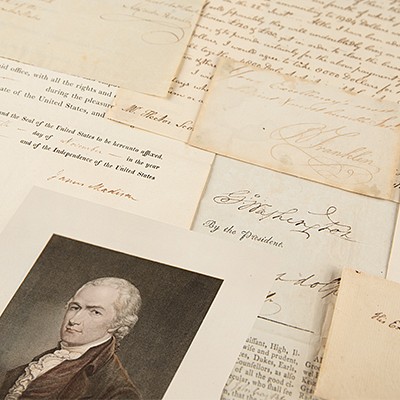President U. S. Grant Seeks to Build a Mexican Canal on the Isthmus of Tehuantepec, an Atlantic-to-Pacific Transportation Route Predating the Panama C
Two ways to bid:
- Leave a max absentee bid and the platform will bid on your behalf up to your maximum bid during the live auction.
- Bid live during the auction and your bids will be submitted real-time to the auctioneer.
Bid Increments
| Price | Bid Increment |
|---|---|
| $0 | $5 |
| $50 | $10 |
| $200 | $25 |
| $500 | $50 |
About Auction
Oct 11, 2023
RR Auction support@rrauction.com
- Lot Description
Partly-printed DS as president, one page, 8 x 10, October 25, 1870. President Grant directs the Secretary of State to “affix the Seal of the United States to my full power to Thomas H. Nelson, Minister to Mexico, to conclude a Convention for a rail-road and canal across the Isthmus of Tehuantepec.” Signed neatly at the conclusion by U.S. Grant. In fine condition, with faint toning and soiling.
This fascinating document relates to what is now known as the Interoceanic Corridor of the Isthmus of Tehuantepec (CIIT), a coast-to-coast transportation project that far predates the Panama Canal. The CIIT remains an ongoing Mexican construction project, under the control of the Secretariat of the Navy, which seeks to connect the Pacific and Atlantic Oceans through a railway system, both for cargo and passengers, that crosses the Isthmus of Tehuantepec, and through the modernization and growth of seaports. As of this writing, the government has declared that the Transisthmic Railway, one of the key elements of the project, has almost finished construction and will be inaugurated either in August or September 2023 and will begin operating at full capacity in December.
Per the Duke University Press: ‘Ulysses S. Grant came to office in 1869 determined to have the United States dig a canal between the Atlantic and Pacific oceans. His interest in the project dated back at least to 1852, when he crossed the Isthmus of Panama at the height of the rainy season with the Fourth United States Infantry Regiment. As Brevet Captain Grant he was the regimental quartermaster responsible for transportation of the unit across the isthmus. More than one hundred men lost their lives during this crossing, mainly because of cholera. Grant never forgot the mud and the intense heat of the jungle; for the rest of his life, he maintained an active interest in an Atlantic-Pacific interoceanic canal route. While serving as chief of staff and acting Secretary of War between 1866 and 1868, he tried unsuccessfully to obtain a survey of the Isthmus of Darién, because he believed this area the most promising for a canal route and knew that most previous isthmian surveys had been superficial. Shortly after his inauguration as president, he ordered Secretary of the Navy Adolph E. Borie to begin preparations for an exploration of the potential Darién routes‰Û_
The expedition reached Darién in late February [1870] and finished an investigation of three routes in this isthmus by June 11. The reports of the investigation shattered Grant’s hopes for immediate construction by eliminating all three possibilities as impracticable. Four other Darién routes were to be examined in the next five years, and all proved unsuitable as canal sites. But the negative findings of this first expedition were enough to convince Secretary of State Hamilton Fish that it was not feasible to build a canal anywhere in the Isthmus of Darién.
On July 12 Congress responded to the discouraging news from Darién by appropriating thirty thousand dollars for surveys of the proposed routes through Nicaragua and Tehuantepec. As the Mexican expedition was preparing to sail in October, Fish privately expressed the view that the Tehuantepec route would be best suited for the construction of a canal. He was soon to be disappointed. In May 1871 the leader of the Mexican expedition returned with a report which described a canal 144 miles long, requiring 140 locks. These estimates appeared to make the cost of the Tehuantepec route prohibitive.’
Thomas Henry Nelson was an Indiana lawyer and politician from Indiana (1824-1896) who was appointed as U.S. Envoy to Chile in 1861 by Abraham Lincoln. On December 8, 1863, he organized rescue operations during the catastrophic Church of the Company Fire in Santiago and was called ‘a true hero of Chile’ for doing so. He earned his second diplomatic position when he was made U.S. Envoy to Mexico in 1869 by Ulysses S. Grant. - Shipping Info
-
Bidder is liable for shipping and handling and providing accurate information as to shipping or delivery locations and arranging for such. RR Auction is unable to combine purchases from other auctions or affiliates into one package for shipping purposes. Lots won will be shipped in a commercially reasonable time after payment in good funds for the merchandise and the shipping fees are received or credit extended, except when third-party shipment occurs. Bidder agrees that service and handling charges related to shipping items which are not pre-paid may be charged to a credit card on file with RR Auction. Successful international Bidders shall provide written shipping instructions, including specified Customs declarations, to RR Auction for any lots to be delivered outside of the United States. NOTE: Declaration value shall be the item’(s) hammer price and RR Auction shall use the correct harmonized code for the lot. Domestic Bidders on lots designated for third-party shipment must designate the common carrier, accept risk of loss, and prepay shipping costs.
-
- Buyer's Premium



 EUR
EUR CAD
CAD AUD
AUD GBP
GBP MXN
MXN HKD
HKD CNY
CNY MYR
MYR SEK
SEK SGD
SGD CHF
CHF THB
THB











